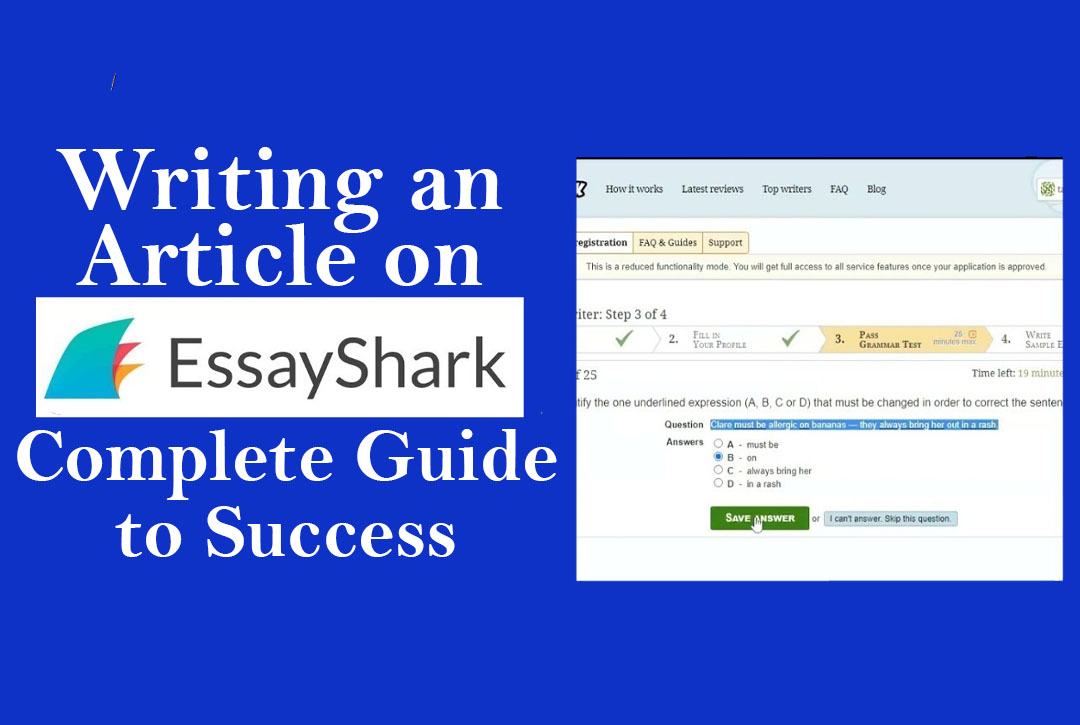Outline
Presentation
Get it, EssayShark’s Stage and audience
Select a clean, centered subject matter
Inquire thoroughly
Arrange your shape
Create a curious adventure
Type in clean, well-organized Paragraphs
Keep a proficient Tone
Alter and edit fastidiously
Optimize for clarity
Take after EssayShark’s pointers
Incorporate a refined end
Keep up improving your abilities
Ending
A way to compose a publication on EssayShark: A total guide
Presentation
Writing a piece of composing on EssayShark, whether as a specialist aiming to energize clients or as an understudy looking for master directing, calls for more than setting words on a web page. Victory depends upon understanding the stage, arranging your piece cautiously, and giving clean, alluring content. This direct strolls you through each step so that you can make articles that meet industry guidelines and master standards.

Get it, EssayShark’s Stage and audience
Before composing, familiarize yourself with EssayShark. It’s a web carrier that interfaces clients with independent journalists for educational, commercial, and creative activities. Articles on the stage might moreover encompass web journal posts, scholarly papers, research rundowns, or how-to courses.
Key focuses to consider:
- Target advertises: clients are regularly students, commercial undertaking experts, or web page activity looking for tried and true insights. Articles have to adjust coherence with depth.
- Tone: EssayShark values polished skill. Type in a clean, unbiased, and aware voice.
- Purpose: Your point is to illuminate or clear up an issue, not to fill the range. Each passage must transfer value.
Select a clean, centered subject matter
The establishment of any tough article is a well-selected theme. On EssayShark, you may be doled out a point, or you would conceivably pitch one yourself.
Recommendations for subject matter selection:
- Suit the platform’s points: consider composing insights, scholarly victory, or inquire about strategies.
- Consider your know-how: choose a subject you recognize or are sharp at researching.
- Preserve it slim: “How to progress Composing competencies for college students” is more focused on than “the way to compose better.”
Create a working recognition early—it guides your thoughts about and makes a difference in the right direction.
Inquire thoroughly
Even if you know the subject, gather solid facts to fortify your article. Use:
- Instructional databases (Google Scholar, JSTOR)
- Authoritative blogs and composing courses
- Dependable records or case studies
Take notes and bookmark sources. Plan them by utilizing significance so that you can cite confirmation suitably and avoid plagiarism.
Arrange your shape
A publication without structure can feel careless. Draft a basic definition:
- Creation
- Hook the perusers with an inquiry, truth, or brief anecdote.
- Explain why the subject is on EssayShark.
- Give up with a proposal or a reason declaration.
- Body Paragraphs
- Divide the substance fabric into 3–5 sections.
- Use headings and subheadings for readability.
- Support claims with cases, insights, or step-by-step commands.
- end
- Summarize key points.
- Offer a takeaway or call to movement (e.g., “apply those steps the next time you type in for EssayShark”).
A clean guide spares time and guarantees you don’t go with the stream off subject matter.
Create a curious adventure
Your starting requires drawing readers in, whereas putting hope. begin with something attention-grabbing:
- A measurement: “Over eighty of EssayShark clients choose articles that include noteworthy suggestions.”
- An explanatory address: “Ever confused what makes an EssayShark article stand out?”
After the snare, give a clarification for why the thing is useful, and then move easily to the fundamental substance material.
Type in clean, well-organized Paragraphs
Each passage require consideration of one essential thought, presented by a subject sentence. Keep up sentences concise—keep absent from over-burdening them with language or filler words. In case you’re clarifying a way, show steps logically:
- Country the step.
- Explain why these subjects.
- Provide an illustration or mini-case study.
Use bullet variables or numbered records sparingly to center on basic rules or sequences.

Keep a proficient Tone
Even in spite of the fact that EssayShark’s group of onlookers may also incorporate students, articles shouldn’t sound excessively casual. Objective for:
- Readability: Type in verifiable English.
- Neutrality: maintain a strategic distance from slang or one-sided language.
- Supportive voice: raise input to criticize.
A charming, however definitive tone builds acceptance with readers.
Alter and edit fastidiously
Never post a draft to begin with. Tough articles on EssayShark reflect cautious revision:
- Content Take a look at: Are all components clean and pertinent? Does the contention float logically?
- Fashion check: overhaul ill-defined words (“matters,” “stuff”) with exact terms.
- Grammar and accentuation: Run a spellchecker; in any case, think out loud to catch errors that a computer program would conceivably miss.
Peer input can moreover offer assistance to refine your paintings.
Optimize for clarity
Internet perusers routinely skim, so make your article clean to navigate:
- Split content with subheadings.
- Use brief passages (three–5 sentences).
- Upload strong or italic accentuation sparingly.
- Contain illustrations, rates, or visuals (in case the stage allows).
Appropriate organizing makes a publication seem masterful and keeps readers engaged.
Take after EssayShark’s pointers
If you’re recording your article for a book or client assessment, double-take a look at stage regulations:
- Phrase check necessities (e.g., 800–1,000 phrases)
- Citation fashion (APA, MLA, Chicago)
- Deadline expectations
- Formatting benchmarks (text style, spacing, margins)
Assembling these necessities illustrates unwavering quality and regard for the platform.
Incorporate a refined end
Your last section must withdraw a persevering effect:
- Summarize the guideline classes.
- Support the thing’s purpose.
- Advise the following step: “Strive sketching out your following piece some time recently drafting—it’s going to save you time.”
A vigorous finish ties your article together and inspires readers to act.
Keep up improving your abilities
EssayShark values scholars who develop with appreciation. To keep up sharpen your craft:
- Read other high-acting articles on the platform.
- Study comments from editors or clients.
- Experiment with unused methodologies (e.g., case studies, interviews, or infographics).
The more you type in and analyze, the more proficient your work becomes.

Ending
Writing an article on EssayShark is both a craft and a subject. It includes know-how such as gathering people, finding completely, providing coherent contemplations, and cleaning each sentence. By following the steps outlined here—selecting a focused subject matter, arranging your structure, keeping clarity, and reexamining carefully—you may create high-quality pieces that stand out on the stage. With hone, you’ll no longer least difficult meet EssayShark’s measures but also develop an adaptable composing portfolio that opens entryways to future opportunities.
FAQs
Q:1. What is EssayShark?
A: EssayShark is an online platform where independent journalists create informative, commercial endeavors, and imaginative content for clients, which incorporates articles, essays, and courses.
Q:2. How long must an EssayShark article be?
A: Most articles drop between 800–1,000 expressions, in spite of the fact that you need to persistently test the special necessities of the wander or platform.
Q:3. Do I need to inquire about putting in a composing an EssayShark article?
A: Yes. Indeed, simple subjects pick up from sound sources, cases, or insights to make the substance fabric precise and persuasive.
Q:4. What tone works great for EssayShark articles?
A: Use a master, clear, and steady tone—informative without being excessively casual or overly academic.
Q:5. How am I able to make my article stand out on EssayShark?
A: cognizance of clear shape, appealing presentations, vigorous illustrations, and cautious improvement to make certain your work is clean and valuable to readers.




